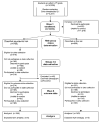Adolescent outcomes of childhood attention-deficit/hyperactivity disorder in a diverse community sample
- PMID: 20494269
- PMCID: PMC2876093
- DOI: 10.1016/j.jaac.2010.03.006
Adolescent outcomes of childhood attention-deficit/hyperactivity disorder in a diverse community sample
Abstract
Objective: To describe adolescent outcomes of childhood attention-deficit/hyperactivity disorder (ADHD) in a diverse community sample.
Method: ADHD screening of a school district sample of 1,615 students aged 5 to 11 years was followed by a case-control study 8 years later. High-risk youths meeting full (n = 94) and subthreshold (n = 75) DSM-IV ADHD criteria were matched with demographically similar low-risk peers (n = 163). Outcomes domains included symptom, functional impairment, quality of life, substance use, educational outcomes, and juvenile justice involvement.
Results: In all, 44% of youths with childhood ADHD had not experienced remission. Compared with unaffected peers, adolescents with childhood ADHD were more likely to display oppositional defiant disorder (odds ratio [OR] = 12.9, 95% confidence interval [CI] 5.6-30.0), anxiety/depression (OR = 10.3, 95% CI 2.7-39.3), significant functional impairment (OR = 3.4, 95% CI 1.7-6.9), reduced quality of life (OR = 2.5, 95% CI 1.3-4.7), and involvement with the juvenile justice system (OR = 3.1, 95% CI 1.0-9.1). Subthreshold ADHD, but not full ADHD, increased the risk of grade retention, whereas both conditions increased the risk of graduation failure. Oppositional defiant disorder (ODD), but not childhood ADHD, increased the risk of cannabis and alcohol use. None of the adolescent outcomes of childhood ADHD were moderated by gender, race or poverty.
Conclusions: ADHD heralds persistence of ADHD and comorbid symptoms into adolescence, as well as significant risks for functional impairment and juvenile justice involvement. Subthreshold ADHD symptoms typically do not qualify affected students for special educational interventions, yet increase the risk for adverse educational outcomes. Findings stress the importance of early ADHD recognition, especially its comorbid presentation with ODD, for prevention and intervention strategies.
2010 American Academy of Child and Adolescent Psychiatry. Published by Elsevier Inc. All rights reserved.
Comment in
-
Children with ADHD at increased risk of adolescent ADHD, ODD, anxiety or depression and functional impairment.Evid Based Ment Health. 2010 Nov;13(4):110. doi: 10.1136/ebmh.13.4.110. Evid Based Ment Health. 2010. PMID: 21036972 No abstract available.
References
-
- Mannuzza S, Klein RG, Bonagura N, Malloy P, Giampino TL, Addalli KA. Hyperactive boys almost grown up. V. Replication of psychiatric status. Arch Gen Psychiatry. 1991 Jan;48(1):77–83. - PubMed
-
- Barkley RA, Fischer M, Smallish L, Fletcher K. Young adult outcome of hyperactive children: adaptive functioning in major life activities. J Am Acad Child Adolesc Psychiatry. 2006 Feb;45(2):192–202. - PubMed


